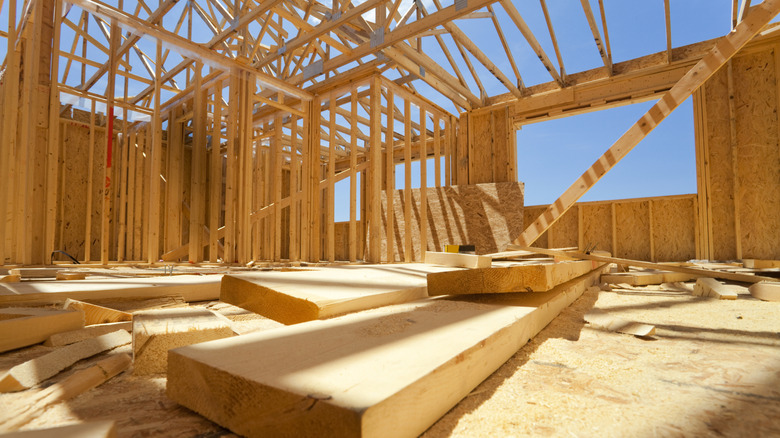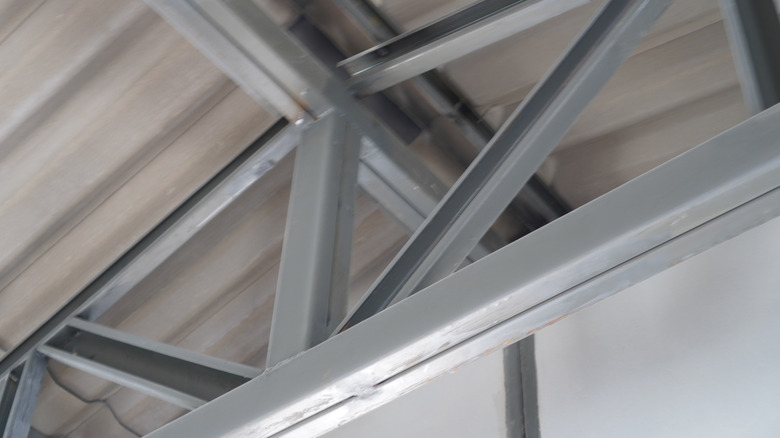Why It Might Be Time To Rethink This Commonly Used Home Building Material
About 90% of all U.S. single-family homes are built with wood, in a trend dating back to the late 1880s. Until now, wood has been the framing material of choice because it's lightweight, readily available, and affordable. But there are valid reasons to rethink this material and start weighing alternatives. Houses built with lumber are incredibly vulnerable in a number of natural disasters, some of which are increasing in pace and intensity. According to a 2025 study from National Oceanic and Atmospheric Administration (NOAA), in 2024, the U.S. experienced 27 climate and natural disasters, each of which caused over $1 billion in damages. This represents a roughly two-fold increase from the 2010s, a decade that averaged about 15 catastrophic, billion-dollar events per year. Apart from climate-related catastrophes, wood-framed homes are also vulnerable to a very common pest — termites.
While lumber isn't the ideal material choice for homes in a world where disasters are becoming more severe and commonplace, its alternatives, like reinforced concrete and steel, seem to offer greater resilience. But just like there are pros and cons of using a wood foundation and frame, concrete and steel have their benefits and drawbacks, too. Below, we take a deeper look at the downsides of lumber in residential home construction and explain why concrete and steel could be worthy replacements for this popular framing material.
The downsides of using wood in homes
Wood framing doesn't stand up well to climate-related natural disasters like tornadoes and hurricanes. Research shows that in wood homes, hurricane-force winds can cause roofs to detach and walls to collapse because of the inherent weakness of structural connections. Hurricanes also often lead to flooding, which may cause wood-framed homes to float away or develop mold outbreaks. Like hurricanes, tornadoes feature strong winds that can reach over 200 miles per hour. These wind forces can rip a wood-framed home off its foundation and even flip it over, causing irreparable damage.
At the same time, studies have shown that wildfires in certain parts of the country are becoming more frequent. Unfortunately, houses built with wood are particularly susceptible because lumber is flammable. A fire can completely destroy a wood-framed home in about 20 minutes.
Another drawback of building houses with lumber is that it's vulnerable to termites, an insect that eats most types of wood. Studies estimate that termites create about $40 billion in damage around the world. If you live in a wood-framed house in a region where termite infestations occur, look out for these signs that it's time to call in a termite professional. If you don't catch an infestation early enough, it can quickly escalate and harm your home.
Why steel and concrete may be better structural materials
Unlike in the U.S., builders in Europe and Latin America have primarily use reinforced concrete to construct homes. The solid, highly durable material has many benefits. For one, properly designed reinforced concrete can withstand 250-mile-per-hour winds, making it resilient in the face of hurricanes and tornadoes.
As an inorganic material, concrete is not a food source for termites, so you won't need to worry about infestations. Crucially, reinforced concrete is also more resistant to wildfires because it's not combustible. It will not ignite the same way lumber will; this means you have a better chance of escaping the property, your belongings are less likely to get damaged, and the house is more likely to stand once the fires recede. That said, homes with a reinforced concrete structure are somewhat susceptible to collapse after exposure to flames and heat. Building with concrete comes with a few other downsides, too. Fewer contractors offer to build homes with this material and, if you find one that does, expect to pay much as 60% more than you would for a wood-frame home.
Another wood alternative is steel. The material can handle fire until it reaches temperatures of around 1,100 degrees Fahrenheit. For example, at least one steel home made it through the 2025 wildfires in Los Angeles. As for hurricanes and tornadoes, steel can tolerate winds up to 160 miles per hour. Among steel's drawbacks are susceptibility to rusting and subsequent weakening when exposed to moisture.


